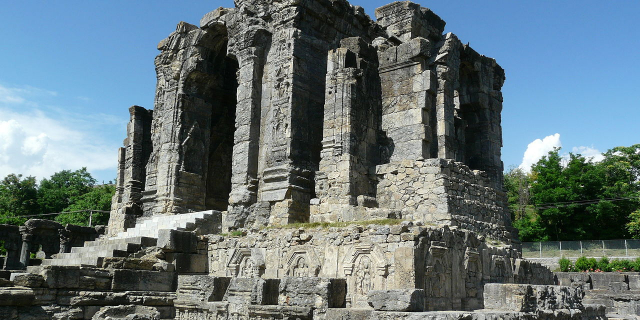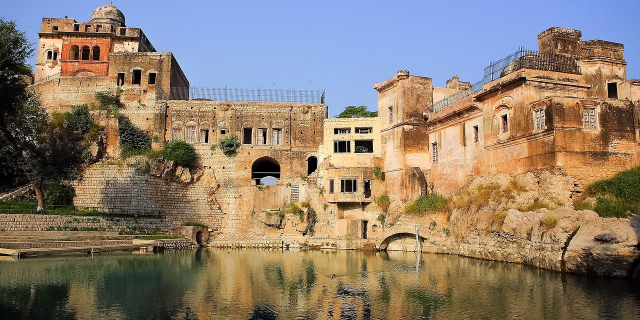Taxila or Takshashila (Punjabi and Urdu: ٹيکسلا; Sanskrit: तक्षशिला, 𑀢𑀓𑁆𑀱𑀰𑀺𑀮𑀸; Pali: Takkasilā; Ashokan Prakrit: 𑀢𑀔𑀲𑀺𑀮𑀸, Takkhasilā; Greek: Τάξιλα, Táxila) is a city in the Pothohar region of Punjab, Pakistan. Located in the Taxila Tehsil of Rawalpindi District, it lies approximately 25 kilometres (16 mi) northwest of the Islamabad–Rawalpindi metropolitan area and is just south of the Haripur District of Khyber Pakhtunkhwa.
Old Taxila was for a time the capital city of ancient Gāndhāra, situated o...Read more
Taxila or Takshashila (Punjabi and Urdu: ٹيکسلا; Sanskrit: तक्षशिला, 𑀢𑀓𑁆𑀱𑀰𑀺𑀮𑀸; Pali: Takkasilā; Ashokan Prakrit: 𑀢𑀔𑀲𑀺𑀮𑀸, Takkhasilā; Greek: Τάξιλα, Táxila) is a city in the Pothohar region of Punjab, Pakistan. Located in the Taxila Tehsil of Rawalpindi District, it lies approximately 25 kilometres (16 mi) northwest of the Islamabad–Rawalpindi metropolitan area and is just south of the Haripur District of Khyber Pakhtunkhwa.
Old Taxila was for a time the capital city of ancient Gāndhāra, situated on the eastern shore of the Indus River—the pivotal junction of the Indian subcontinent and Central Asia; it was founded around 1000 BCE. Some ruins at Taxila date to the time of the Achaemenid Persian Empire. In 326 BCE, the city was conquered by Alexander the Great who gained control of the city without a battle since the city was immediately surrendered to the Macedonian Empire. This was followed successively by the Maurya Empire, the Indo-Greek Kingdom, the Indo-Scythians, and the Kushan Empire. Owing to its strategic location, Taxila has changed hands many times over the centuries, with many polities vying for its control. When the great ancient trade routes connecting these regions ceased to be important, the city sank into insignificance and was finally destroyed in the 5th century by the invading Hunas. In mid-19th century British India, ancient Taxila's ruins were rediscovered by British archaeologist Alexander Cunningham and extensively excavated by Sir John Marshall. In 1980, UNESCO designated Taxila as a World Heritage Site.
By some accounts, the University of ancient Taxila is considered to be one of the earliest universities or education centre in South Asia. Other scholars do not consider it to have been a university in the modern sense, in that the teachers living there may not have had official membership of particular colleges, and there did not seem to have existed purpose-built lecture halls and residential quarters in the city. In a 2010 report, the Global Heritage Fund identified Taxila as one of 12 worldwide sites that were "on the verge" of irreparable loss and damage, citing insufficient management, development pressure, looting, and armed conflict as primary threats. However, significant preservation efforts have since been carried out by the Pakistani government, which has resulted in the site's recategorization as "well-preserved" by different international publications. Because of the extensive preservation efforts and upkeep, Taxila is one of Punjab's popular tourist spots, attracting up to one million tourists every year.
The region around Taxila was settled by the Neolithic era, with some ruins at Taxila dating to 1000 BCE.[1][2] Ruins dating from the Early Harappan period around 1300 BCE[1] have also been discovered in the Taxila area,[2] though the area was eventually abandoned after the collapse of the Indus Valley civilisation.
The earliest settled occupation in Taxila Valley was found at Sarai Khola, located 2 km to the south-west of Taxila Museum, where three radiocarbon dates from Period I suggest the site was first occupied between the late 4th and early 3rd millennium BCE, with deposits of polished stone celts, chert blades and a distinctive type of highly burnished pottery that shows clear signs of the use of woven baskets in the manufacturing process and the application of a slurry to the exterior surface.[3]
Periods IA and II at Sarai Khola seem to show continuity from Period I, with the appearance of red burnished wares. However, Kot Diji-style wares were found in greater numbers, and the Kot Diji-style forms show signs of having been wheel-thrown, marking a clear technological change from the Period I material. Seven radiocarbon dates were also taken from the earlier and later Period II/Kot Diji, and seem to show this phase dates from the mid-late 3rd to early 2nd millennium BCE.[3]
Gandhāra kingdomGandhara was an ancient Indo-Aryan kingdom of western South Asia whose existence was attested during the Iron Age. The capital of the kingdom was in Taxila. The first major settlement at Taxila, in Hathial mound, was established around 1000 BCE.[4][5][6] By 900 BCE, the city was already involved in regional commerce, as the discovered pottery shards reveal trading ties between the city and Puṣkalāvatī.[7]
Later, Taxila was inhabited at Bhir Mound, dated to some time around the period 800-525 BCE with these early layers bearing grooved red burnished ware.[8]
 Eastern border of the Achaemenid EmpireAchaemenid Empire
Eastern border of the Achaemenid EmpireAchaemenid Empire
Archaeological excavations show that the city may have grown significantly during the rule of the Persian Achaemenid Empire in the 6th century BCE. In 516 BCE, Darius I embarked on a campaign to conquer Central Asia, Ariana and Bactria, before marching onto what is now Afghanistan and northern Pakistan. Emperor Darius spent the winter of 516-515 BCE in the Gandhara region surrounding Taxila, and prepared to conquer the Indus Valley, which he did in 515 BCE,[9] after which he appointed Scylax of Caryanda to explore the Indian Ocean from the mouth of the Indus to the Suez. Darius then returned to Persia via the Bolan Pass. The region continued under Achaemenid suzerainty under the reign of Xerxes I, and continued under Achaemenid rule for over a century.[10]
Taxila was sometimes ruled as part of the Gandhara kingdom (whose capital was Pushkalavati), particularly after the Achaemenid period, but Taxila sometimes formed its own independent district or city-state.[11][12]
Hellenistic A map of Alexander's campaign in ancient India.
A map of Alexander's campaign in ancient India.During his invasion of the Indus Valley, Alexander the Great was able to gain control of Taxila (Ancient Greek: Τάξιλα)[13] in 326 BCE without a battle, as the city was surrendered by its ruler, king Omphis (Āmbhi).[10] Greek historians accompanying Alexander described Taxila as "wealthy, prosperous, and well governed".[10] Arrian writes that Alexander was welcomed by the citizens of the city, and he offered sacrifices and celebrated a gymnastic and equestrian contest there.[14]
On Alexander's death, in 323 BCE, the province and much of the once Achaemenid territories would pass to his general Seleucus I Nicator and founder of the successor Seleucid Empire.
Mauryan Empire Extent of the Mauryan Empire (600 - 180 BCE)
Extent of the Mauryan Empire (600 - 180 BCE)By 303 BCE, the Seleucid Empire's satraps in South Asia had been formally annexed by the expanding Mauryan empire, following the Seleucid–Mauryan war,[15] with the provincial capital and center of higher education at of Taxila now under the control of Chandragupta Maurya. His advisor, Kautilya/Chanakya, was said to have taught at Taxila's university.[16] Under the reign of Ashoka the Great, Chandragupta's grandson, the city was made a great seat of Buddhist learning, though the city was home to a minor rebellion during this time.[17]
Taxila was founded in a strategic location along the ancient "Royal Highway" that connected the Mauryan capital at Pataliputra in Bihar, with ancient Peshawar, Puṣkalāvatī, and onwards towards Central Asia via Kashmir, Bactria, and Kāpiśa.[18] Taxila thus changed hands many times over the centuries, with many empires vying for its control.
Indo-Greek, Indo-Scythian, and Indo-Parthian KingdomsIn the 2nd century BCE, Taxila was annexed by the Indo-Greek kingdom of Bactria. Indo-Greeks built a new capital, Sirkap, on the opposite bank of the river from Taxila.[19] During this new period of Bactrian Greek rule, several dynasties (like Antialcidas) likely ruled from the city as their capital. During lulls in Greek rule, the city managed profitably on its own, to independently control several local trade guilds, who also minted most of the city's autonomous coinage. In about the 1st century BCE or 1st century CE, an Indo-Scythian king named Azilises had three mints, one of which was at Taxila, and struck coins with obverse legends in Greek and Kharoṣṭhī.
The last Greek king of Taxila was overthrown by the Indo-Scythian chief Maues around 90 BCE.[20] Gondophares, founder of the Indo-Parthian Kingdom, conquered Taxila around 20 BCE, and made Taxila his capital.[21] According to early Christian legend, Thomas the Apostle visited Gondophares IV around 46 CE,[22] possibly at Taxila given that city was Gondophares' capital city.
Kushan EmpireAround the year 50 CE, the Greek Neopythagorean philosopher Apollonius of Tyana allegedly visited Taxila, which was described by his biographer, Philostratus, writing some 200 years later, as a fortified city laid out on a symmetrical plan, similar in size to Nineveh. Modern archaeology confirms this description.[23] Inscriptions dating to 76 CE demonstrate that the city had come under Kushan rule by that time, after the city was captured from the Parthians by Kujula Kadphises, founder of the Kushan Empire.[24] The great Kushan ruler Kanishka later founded Sirsukh, the most recent of the ancient settlements at Taxila.
Gupta EmpireIn the mid-fourth century CE, the Gupta Empire occupied the territories in Eastern Gandhara, establishing a Kumaratya's post at Taxila. The city became well known for its trade links, including silk, sandalwood, horses, cotton, silverware, pearls, and spices. It is during this time that the city heavily features in classical Indian literature – both as a centre of culture as well as a militarised border city.[25][26]
Taxila's university remained in existence during the travels of Chinese pilgrim Faxian, who visited Taxila around 400 CE.[27] He wrote that Taxila's name translated as "the Severed Head", and was the site of a story in the life of Buddha "where he gave his head to a man".[28]
DeclineThe Kidarites, vassals of the Hephthalite Empire are known to have invaded Taxila in c. 450 CE. Though repelled by the Gupta Emperor Skandagupta, the city would not recover- probably on account of the strong Hunnic presence in the area, breakdown of trade as well as the three-way war among Persia, the Kidarite State, and the Huns in Western Gandhara.
The White Huns and Alchon Huns swept over Gandhāra and Punjab around 470 CE, causing widespread devastation and destruction of Taxila's famous Buddhist monasteries and stupas, a blow from which the city would never recover. From 500 CE to 540 CE, the city languished [29] after falling under the control of the Hunnic Empire ruled by Mihirakula. Mihirakula presided over some destruction of Buddhist sites, monasteries and Hindu temples across northwestern regions of the Indian subcontinent.[30][31]
Xuanzang visited India between 629 and 645 CE. Taxila which was desolate and half-ruined was visited by him in 630 CE, and found most of its sangharamas still ruined and desolate. Only a few monks remained there. He adds that the kingdom had become a dependency of Kashmir with the local leaders fighting amongst themselves for power. He noted that it had some time previously been a subject of Kapisa. By the ninth century, it became a dependency of the Kabul Shahis. The Turki Shahi dynasty of Kabul was replaced by the Hindu Shahi dynasty which was overthrown by Mahmud of Ghazni with the defeat of Trilochanpala.[32][33]
Al-Usaifan's king during the reign of Al-Mu'tasim is said to have converted to Islam by Al-Biladhuri and abandoned his old faith due to the death of his son despite having priests of a temple pray for his recovery. Said to be located between Kashmir, Multan and Kabul, al-Usaifan is identified with kingdom of Taxila by some authors.[34][35]



































Add new comment